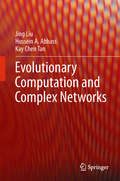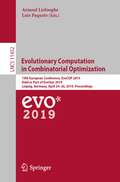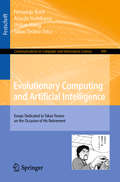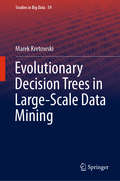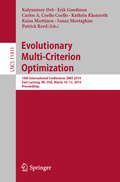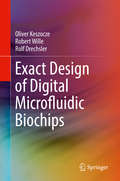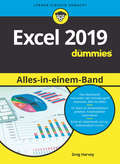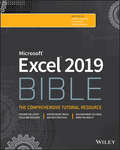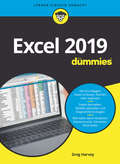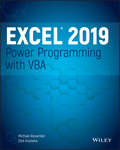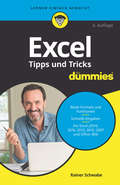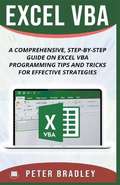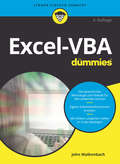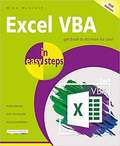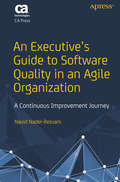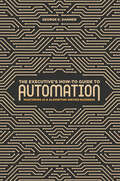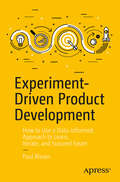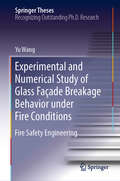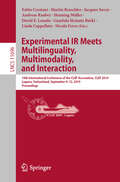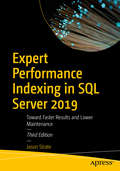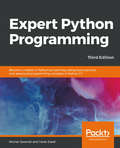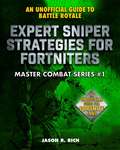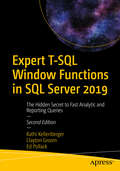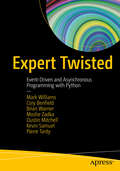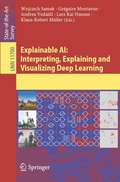- Table View
- List View
Evolutionary Computation and Complex Networks
by Jing Liu Hussein A. Abbass Kay Chen TanThis book introduces the linkage between evolutionary computation and complex networks and the advantages of cross-fertilising ideas from both fields. Instead of introducing each field individually, the authors focus on the research that sits at the interface of both fields. The book is structured to address two questions: (1) how complex networks are used to analyze and improve the performance of evolutionary computation methods? (2) how evolutionary computation methods are used to solve problems in complex networks? The authors interweave complex networks and evolutionary computing, using evolutionary computation to discover community structure, while also using network analysis techniques to analyze the performance of evolutionary algorithms. The book is suitable for both beginners and senior researchers in the fields of evolutionary computation and complex networks.
Evolutionary Computation in Combinatorial Optimization: 19th European Conference, EvoCOP 2019, Held as Part of EvoStar 2019, Leipzig, Germany, April 24–26, 2019, Proceedings (Lecture Notes in Computer Science #11452)
by Arnaud Liefooghe Luís PaqueteThis book constitutes the refereed proceedings of the 19th European Conference on Evolutionary Computation in Combinatorial Optimization, EvoCOP 2019, held as part of Evo* 2019, in Leipzig, Germany, in April 2019, co-located with the Evo* 2019 events EuroGP, EvoMUSART and EvoApplications.The 14 revised full papers presented were carefully reviewed and selected from 37 submissions. The papers cover a wide spectrum of topics, ranging from the foundations of evolutionary computation algorithms and other search heuristics to their accurate design and application to both single- and multi-objective combinatorial optimization problems. Fundamental and methodological aspects deal with runtime analysis, the structural properties of fitness landscapes, the study of metaheuristics core components, the clever design of their search principles, and their careful selection and configuration. Applications cover domains such as scheduling, routing, partitioning and general graph problems.
Evolutionary Computing and Artificial Intelligence: Essays Dedicated to Takao Terano on the Occasion of His Retirement (Communications in Computer and Information Science #999)
by Fernando Koch Atsushi Yoshikawa Shihan Wang Takao TeranoThis Festschrift volume is published in honor of Takao Terano on the occasion of his retirement. Takao Terano is a leading expert in the areas of agent-based modelling, knowledge systems, evolutionary computation, and service science.The contributions in this volume reflect the breadth and impact of his work. The volume contains 12 full papers related to Takao Terano’s research. They deal with various aspects of artificial intelligence, multi-agent systems, collaborative and social computing, social networks, ubiquitous computing.
Evolutionary Decision Trees in Large-Scale Data Mining (Studies in Big Data #59)
by Marek KretowskiThis book presents a unified framework, based on specialized evolutionary algorithms, for the global induction of various types of classification and regression trees from data. The resulting univariate or oblique trees are significantly smaller than those produced by standard top-down methods, an aspect that is critical for the interpretation of mined patterns by domain analysts. The approach presented here is extremely flexible and can easily be adapted to specific data mining applications, e.g. cost-sensitive model trees for financial data or multi-test trees for gene expression data. The global induction can be efficiently applied to large-scale data without the need for extraordinary resources. With a simple GPU-based acceleration, datasets composed of millions of instances can be mined in minutes. In the event that the size of the datasets makes the fastest memory computing impossible, the Spark-based implementation on computer clusters, which offers impressive fault tolerance and scalability potential, can be applied.
Evolutionary Multi-Criterion Optimization: 10th International Conference, EMO 2019, East Lansing, MI, USA, March 10-13, 2019, Proceedings (Lecture Notes in Computer Science #11411)
by Kalyanmoy Deb Erik Goodman Carlos A. Coello Coello Kathrin Klamroth Kaisa Miettinen Sanaz Mostaghim Patrick ReedThis book constitutes the refereed proceedings of the 10th International Conference on Evolutionary Multi-Criterion Optimization, EMO 2019 held in East Lansing, MI, USA, in March 2019.The 59 revised full papers were carefully reviewed and selected from 76 submissions. The papers are divided into 8 categories, each representing a key area of current interest in the EMO field today. They include theoretical developments, algorithmic developments, issues in many-objective optimization, performance metrics, knowledge extraction and surrogate-based EMO, multi-objective combinatorial problem solving, MCDM and interactive EMO methods, and applications.
Exact Design of Digital Microfluidic Biochips
by Oliver Keszocze Robert Wille Rolf DrechslerThis book presents exact, that is minimal, solutions to individual steps in the design process for Digital Microfluidic Biochips (DMFBs), as well as a one-pass approach that combines all these steps in a single process. All of the approaches discussed are based on a formal model that can easily be extended to cope with further design problems. In addition to the exact methods, heuristic approaches are provided and the complexity classes of various design problems are determined.Presents exact methods to tackle a variety of design problems for Digital Microfluidic Biochips (DMFBs);Describes an holistic, one-pass approach solving different design steps all at once;Based on a formal model of DMFBs that is easily adaptable to deal with further design tasks.
Excel 2019 Alles-in-einem-Band für Dummies (Für Dummies)
by Greg HarveyDieses Buch lässt keine Excel-Wünsche offen: Es beschreibt grundlegende Excel-Funktionen, wie das Erstellen und Bearbeiten von Arbeitsblättern, aber auch das Teilen und Überarbeiten von Dokumenten oder das Bearbeiten von Makros mit Visual Basic. Darüber hinaus: Arbeitsblätter formatieren und schützen, Formeln erstellen, Daten importieren, in Diagrammen darstellen und mit Statistikfunktionen auswerten, Pivot-Tabellen erzeugen, Was-wäre-wenn-Szenarien und Webabfragen durchführen, Datenbankfunktionen nutzen, Makros erstellen und ausführen, Excel in Verbindung mit Power BI nutzen und noch vieles mehr. Mit diesem Buch suchen Sie nicht mehr endlos nach Excel-Funktionen, sondern haben mehr Zeit für Ihre Projekte!
Excel 2019 Bible (Bible)
by Michael Alexander Richard Kusleika John WalkenbachThe complete guide to Excel 2019 Whether you are just starting out or an Excel novice, the Excel 2019 Bible is your comprehensive, go-to guide for all your Excel 2019 needs. Whether you use Excel at work or at home, you will be guided through the powerful new features and capabilities to take full advantage of what the updated version offers. Learn to incorporate templates, implement formulas, create pivot tables, analyze data, and much more. Navigate this powerful tool for business, home management, technical work, and much more with the only resource you need, Excel 2019 Bible. Create functional spreadsheets that work Master formulas, formatting, pivot tables, and more Get acquainted with Excel 2019's new features and tools Whether you need a walkthrough tutorial or an easy-to-navigate desk reference, the Excel 2019 Bible has you covered with complete coverage and clear expert guidance.
Excel 2019 für Dummies (Für Dummies)
by Greg HarveyWenn schon der Gedanke an Excel-Arbeitsblätter Ihnen Kopfschmerzen macht, ist dieses Buch das richtige für Sie. Dieser praktische Leitfaden wird Sie mit der neuesten Version der Software, Microsoft Excel 2019, vertraut machen. Im Handumdrehen können Sie Arbeitsblätter erstellen und bearbeiten, Zellen formatieren, Formeln eingeben, Diagramme erstellen und bearbeiten, Diagramme einfügen, Datenbankformulare entwerfen und vieles mehr. Außerdem erhalten Sie eine leicht verständliche Anleitung für fortgeschrittene Excel-Fertigkeiten, wie das Hinzufügen von Hyperlinks zu Arbeitsblättern, das Speichern von Arbeitsblättern als Webseiten, das Hinzufügen von Arbeitsblattdaten zu einer bestehenden Webseite und vieles mehr.
Excel 2019 Power Programming with VBA
by Michael Alexander Dick KusleikaMaximize your Excel experience with VBA Excel 2019 Power Programming with VBA is fully updated to cover all the latest tools and tricks of Excel 2019. Encompassing an analysis of Excel application development and a complete introduction to Visual Basic for Applications (VBA), this comprehensive book presents all of the techniques you need to develop both large and small Excel applications. Over 800 pages of tips, tricks, and best practices shed light on key topics, such as the Excel interface, file formats, enhanced interactivity with other Office applications, and improved collaboration features. Understanding how to leverage VBA to improve your Excel programming skills can enhance the quality of deliverables that you produce—and can help you take your career to the next level. Explore fully updated content that offers comprehensive coverage through over 900 pages of tips, tricks, and techniques Leverage templates and worksheets that put your new knowledge in action, and reinforce the skills introduced in the text Improve your capabilities regarding Excel programming with VBA, unlocking more of your potential in the office Excel 2019 Power Programming with VBA is a fundamental resource for intermediate to advanced users who want to polish their skills regarding spreadsheet applications using VBA.
Excel Tipps und Tricks für Dummies (Für Dummies)
by Rainer W. SchwabeErfahren Sie, wie Sie mit Excel noch schneller, besser und effizienter arbeiten! Zeigen Sie im Excel-Alltag richtiges Fachwissen. Verwenden Sie gelungene Mixturen aus raffinierten Formeln und Funktionen. Holen Sie zum Beispiel mehr aus WENN-Funktionen heraus, ohne dass es ein ABER gibt. Nutzen Sie im Programm Verborgenes. Dieses Buch zeigt Ihnen neben vielen Tipps, Tricks und Tastenkombinationen auch Top-Secrets für den direkten Einsatz, die nicht jeder kennt und im Geheimen schlummern.
Excel VBA: A Step-By-Step Comprehensive Guide on Excel VBA Programming Tips and Tricks for Effective Strategies
by Peter BradleyIf you want to take Excel to the next level, and improve your knowledge in VBA, you should learn how to implement the tools and functions that VBA offers in your work. If your aim is to improve and automate processes using Excel VBA, you have come to the right place. Over the course of the book, you will gather information on a wide array of tools and Excel options. The book will take you through some facts about Excel VBA and will also leave you with some tips that you can use to improve the processing speed of VBA. This book is packed with some friendly advice on the easiest methods that you can use to develop sub procedures, and the many ways in which you can call them. If you have some knowledge about Excel VBA, and want to improve your skills in programming with VBA then this book is for you.
Excel-VBA für Dummies (Für Dummies)
by John WalkenbachUm noch mehr aus Excel herauszuholen, sind Kenntnisse der VBA-Programmierung von großem Vorteil: Dann können Sie Excel auf Ihre Bedürfnisse zuschneiden und langweilige Routinearbeiten automatisieren. Dieses Buch zeigt Ihnen zunächst den Umgang mit dem VBA-Editor und gibt einen Einblick in die wichtigsten Programmiertechniken, wie Fehler beseitigen, Range-Objekte einsetzen und den Programmfluss steuern. Lernen Sie dann die vielfältigen Programmiermöglichkeiten kennen. Alle Beispielprogramme und Arbeitsblätter stehen zum Download zur Verfügung. Sie werden staunen: Mit VBA können Sie sich selbst Dialogboxen, Werkzeugleisten und Menüs schneidern. Und das schon nach kurzer Zeit!
Excel VBA In Easy Steps: Covers Visual Studio Community 2017
by Mike McGrathExcel VBA in easy steps neatly demonstrates VBA (Visual Basic for Applications) Macro programming in a clear and concise manner, so you can get more from the popular Microsoft Excel spreadsheet application. <p><p> Whether you’re upgrading to Excel 2019, exploring Excel in the Office 365 suite, or new to the Macro programming concept, use this guide to learn the key features constructively and get more out of Microsoft Excel – in easy steps!
An Executive’s Guide to Software Quality in an Agile Organization: A Continuous Improvement Journey
by Navid Nader-RezvaniUtilize a set of practical guidelines to help your Agile organization elevate software design quality as an important business driver to achieve customer satisfaction and, ultimately, higher revenue for your company. This is the first book to focus on a holistic quality view—what it is and how it links to overall business enhancements. The real-world examples used in this book allow you to learn and apply similar strategies and guidelines to help create a quality blueprint for your organization. Five pillars of quality are defined that can be used for any industry and, once internalized, can serve as a set of tools to continuously improve and measure the key factors impacting quality.What You’ll Learn Be aware of the key elements in any transformation that involves culture Link quality and business outcomes Understand quality and its holistic definition and why continuous improvement is still a relevant approach in enhancing quality Follow guidelines with specific examples that can be applied to any product release in any type of industry to improve quality and enhance Agile processes Utilize relevant metrics to measure and continuously improve to make incremental positive changes Who This Book Is For Individuals at various levels in organizations—from Agile scrum teams, all the way up to executive leadership
The Executive's How-To Guide to Automation: Mastering Ai And Algorithm-driven Business
by George E. DannerFrom driverless cars to pilotless planes, many functions that have previously required human labor can now be performed using artificial intelligence. For businesses, this use of AI results in reduced labor costs and, even more important, creating a competitive advantage. How does one look at any organization and begin the work of automating it in sensible ways? This book provides the blueprint for automating critical business functions of all kinds. It outlines the skills and technologies that must be brought to bear on replicating human-like thinking and judgment in the form of algorithms. Many believe that algorithm design is the exclusive purview of computer scientists and experienced programmers. This book aims to dispel that notion. An algorithm is merely a set of rules, and anyone with the ability to envision how different components of a business can interact with other components already has the ability to work in algorithms. Though many fear that the use of automation in business means human labor will no longer be needed, the author argues that organizations will re-purpose humans into different roles under the banner of automation, not simply get rid of them. He also identifies parts of business that are best targeted for automation. This book will arm business people with the tools needed to automate companies, making them perform better, move faster, operate cheaper, and provide great lasting value to investors.
Experiment-Driven Product Development: How to Use a Data-Informed Approach to Learn, Iterate, and Succeed Faster
by Paul RissenImproving your craft is a key skill for product and user experience professionals working in the digital era. There are many established methods of product development to inspire and focus teams—Sprint, Lean, Agile, Kanban—all of which focus on solutions to customer and business problems. Enter XDPD, or Experiment-Driven Product Development—a new approach that turns the spotlight on questions to be answered, rather than on solutions.Within XDPD, discovery is a mindset, not a project phase. In Experiment-Driven Product Development, author Paul Rissen introduces a philosophy of product development that will hone your skills in discovery, research and learning. By guiding you through a practical, immediately applicable framework, you can learn to ask, and answer, questions which will supercharge your product development, making teams smarter and better at developing products and services that deliver for users and businesses alike. When applying the XDPD framework within your organization, the concept of an experiment—a structured way of asking, and answering, questions—becomes the foundation of almost everything you do, instilling a constant sense of discovery that keeps your team inspired. All types of activities, from data analysis to writing software, are seen through the lens of research. Rather than treating research as a separate task from the rest of product development, this book approaches the entire practice as one of research and continuous discovery.Designing successful experiments takes practice. That’s where Rissen’s years of industry expertise come in. In this book, you are given step-by-step tools to ensure that meaningful, efficient progress is made with each experiment. This approach will prove beneficial to your team, your users, and most importantly, to your product’s lasting success.Experiment-Driven Product Development offers a greater appreciation of the craft of experimentation and helps you adapt it in your own context. In our modern age of innovation, XDPD can put you ahead. Go forth and experiment!What You Will LearnKnow how to approach product development in a leaner, more efficient wayUnderstand where and when experiments can be useful, and how they fit into pre-existing organization environments and processesRealize why you should be thinking about the simplest, useful thing rather than the minimum, viable productDiscover how to break down feature and design ideas into the assumptions and the premises that lie behind themAppreciate the importance of designing your experiments, and the statistical concepts that underpin their successMaster the art of communicating the results of experiments back to stakeholders, and help the results guide what happens nextWho This Book is ForProfessionals working in digital product design and development, user experience, and service design. This book is best suited for those who work on digital products every day and want to adopt better approaches to gaining knowledge about their users, what works, and what does not work.
Experimental and Numerical Study of Glass Façade Breakage Behavior under Fire Conditions: Fire Safety Engineering (Springer Theses)
by Yu WangThis book presents the comprehensive results of experimental and numerical investigations of glass façade breakage behavior under fire conditions. First of all, full-scale frame and point-supported glass façades, incorporating single, double and coated glazing, were tested under pool fire conductions. The results determined the effects of different glass frames, types of glass, and thermal shocks on breakage behavior. Small-scale tests, using the Material Testing System (MTS) 810, Netzsch Dilatometer and FE-SEM, were also performed at different temperatures to determine the basic mechanical properties of glazing.In addition, a three-dimensional dynamic model was developed to predict stress distribution, crack initiation and propagation, and has since been employed to identify the breakage mechanisms of different types of glass façade. The numerical results showed very good agreement with the experimental results and verified the model’s ability to accurately predict breakage. Lastly, a theoretical model based on incident heat flux was developed to predict the breakage time and heat transfer in glazing, which served to reveal the nature of interactions between fire and glass.
Experimental IR Meets Multilinguality, Multimodality, and Interaction: 10th International Conference of the CLEF Association, CLEF 2019, Lugano, Switzerland, September 9–12, 2019, Proceedings (Lecture Notes in Computer Science #11696)
by Fabio Crestani Martin Braschler Jacques Savoy Andreas Rauber Henning Müller David E. Losada Gundula Heinatz Bürki Linda Cappellato Nicola FerroThis book constitutes the refereed proceedings of the 10th International Conference of the CLEF Association, CLEF 2019, held in Lugano, Switzerland, in September 2019.The conference has a clear focus on experimental information retrieval with special attention to the challenges of multimodality, multilinguality, and interactive search ranging from unstructured to semi structures and structured data. The 7 full papers and 8 short papers presented in this volume were carefully reviewed and selected from 30 submissions. This year, many contributions tackle the social networks with the detection of stances or early identification of depression signs on Twitter in a cross-lingual context. Further this volume presents 7 “best of the labs” papers which were reviewed as a full paper submission with the same review criteria. The labs represented scientific challenges based on new data sets and real world problems in multimodal and multilingual information access. In addition to this, 9 benchmarking labs reported results of their yearlong activities in overview talks and lab sessions.
Expert Performance Indexing in SQL Server 2019: Toward Faster Results and Lower Maintenance
by Jason StrateTake a deep dive into perhaps the single most important facet of good performance: indexes, and how to best use them. Recent updates to SQL Server have made it possible to create indexes in situations that in the past would have prevented their use.Other improvements covered in this book include new dynamic management views, the ability to pause and resume index maintenance, and the ability to more easily recover from failures during index creation and maintenance operations. This new edition also brings new content around the indexing of columnstore and in-memory tables, showing how these new types of tables and the queries that execute against them can also benefit from good indexing practices. The book begins with explanations of the types of indexes and how they are stored in databases. Moving deeper into the topic, and further into the book, you will look at the statistics that are accumulated both by indexes and on indexes. You will better understand what indexes are doing in the database and what can be done to mitigate and improve their effect on performance. You will get a look at the Index Advisor now available in Azure SQL Database, and learn how to review and maintain the health of your indexes. The final chapters present a guided tour through a number of scenarios showing approaches you can take to investigate, mitigate, and improve the performance of your database.What You Will LearnProperly index row store, columnstore, and in-memory tablesReview statistics to understand indexing choices made by the optimizerApply indexing strategies such as covering indexes, included columns, and index intersectionsRecognize and remove unnecessary indexesDesign effective indexes for full-text, spatial, and XML data typesManage the big picture: Encompass all indexes in a database, and all database instances on a serverWho This Book Is ForDatabase administrators and developers who are ready to lift the performance of their database environment by thoughtfully building indexes to speed up queries that matter the most and make a difference to the business
Expert Python Programming,: Become a master in Python by learning coding best practices and advanced programming concepts in Python 3.7, 3rd Edition
by Michał Jaworski Tarek ZiadéRefine your Python programming skills and build professional grade applications with this comprehensive guideKey FeaturesCreate manageable code that can run in various environments with different sets of dependenciesImplement effective Python data structures and algorithms to write optimized codeDiscover the exciting new features of Python 3.7Book DescriptionPython is a dynamic programming language that's used in a wide range of domains thanks to its simple yet powerful nature. Although writing Python code is easy, making it readable, reusable, and easy to maintain is challenging. Complete with best practices, useful tools, and standards implemented by professional Python developers, the third edition of Expert Python Programming will help you overcome this challenge.The book will start by taking you through the new features in Python 3.7. You'll then learn the advanced components of Python syntax, in addition to understanding how to apply concepts of various programming paradigms, including object-oriented programming, functional programming, and event-driven programming. This book will also guide you through learning the best naming practices, writing your own distributable Python packages, and getting up to speed with automated ways of deploying your software on remote servers. You’ll discover how to create useful Python extensions with C, C++, Cython, and CFFI. Furthermore, studying about code management tools, writing clear documentation, and exploring test-driven development will help you write clean code.By the end of the book, you will have become an expert in writing efficient and maintainable Python code.What you will learnExplore modern ways of setting up repeatable and consistent development environmentsPackage Python code effectively for community and production useLearn modern syntax elements of Python programming such as f-strings, enums, and lambda functionsDemystify metaprogramming in Python with metaclassesWrite concurrent code in PythonExtend Python with code written in different languagesIntegrate Python with code written in different languagesWho this book is forThis book will appeal to you if you’re a programmer looking to take your Python knowledge to the next level by writing efficient code and learning the latest features of version 3.7 and above.
Expert Sniper Strategies for Fortniters: An Unofficial Guide to Battle Royale (Master Combat)
by Jason RichHit your target every time with this Fortnite expert sniper guide. This all‑new, unofficial, illustrated guide series will turn you into a master Fortnite: Battle Royale gamer by uncovering all the best strategies and secrets of this wildly popular game. Whether you play Fortnite Battle Royale on a PC, Mac, Xbox One, PlayStation 4, or your mobile device, you’ll find everything you need to stay at the top of your game. Each book is packed with useful insider tips on topics like, staying alive longer, exploring, collecting a powerful arsenal, building, and snagging more victories during each match. When it comes to achieving #1 Victory Royale, the Fortnite Battle Royale: Master Combat Series provides the ultimate competitive edge. Thanks to this comprehensive how‑to Fortnite shooting guide, you’ll gain the crucial battle skills you need to eliminate your enemies like a pro. Sniper rifles and projectile weapons are only as good as the player using them. This comprehensive resource will sharpen your skills and show you how and when to use the incredible range of guns, weapons, tools, and ammunition available during each match. There’s nothing more important in Fortnite than staying alive longer and battling your way to #1 Victory Royale. This straightforward guide has everything you need to prepare for long‑range, mid‑range, and close‑range combat situations so that you can emerge a winner.
Expert T-SQL Window Functions in SQL Server 2019: The Hidden Secret to Fast Analytic and Reporting Queries
by Kathi Kellenberger Clayton Groom Ed PollackBecome an expert who can use window functions to solve T-SQL query problems. Replace slow cursors and self-joins with queries that are easy to write and perform better. This new edition provides expanded examples, including a chapter from the world of sports, and covers the latest performance enhancements through SQL Server 2019. Window functions are useful in analytics and business intelligence reporting. They came into full blossom with SQL Server 2012, yet they are not as well known and used as often as they ought to be. This group of functions is one of the most notable developments in SQL, and this book shows how every developer and DBA can benefit from their expressive power in solving day-to-day business problems. Once you begin using window functions, such as ROW_NUMBER and LAG, you will discover many ways to use them. You will approach SQL Server queries in a different way, thinking about sets of data instead of individual rows. Your queries will run faster, be easier to write, and easier to deconstruct, maintain, and enhance in the future.Just knowing and using these functions is not enough. You also need to understand how to tune the queries. Expert T-SQL Window Functions in SQL Server clearly explains how to get the best performance. The book also covers the rare cases when older techniques are the best bet.What You Will LearnSolve complex query problems without cumbersome self-joins that run slowly and are difficult to readCreate sliding windows in a result set for computing such as running totals and moving averagesReturn aggregate and detail data simultaneously from the same SELECT statementCompute lag and lead and other values that access data from multiple rows in a result setUnderstand the OVER clause syntax and how to control the windowAvoid framing errors that can lead to unexpected resultsWho This Book Is For Anyone who writes T-SQL queries, including database administrators, developers, business analysts, and data scientists. Before reading this book, you should understand how to join tables, write WHERE clauses, and build aggregate queries.
Expert Twisted: Event-driven And Asynchronous Programming With Python
by Pierre Tardy Kevin Samuel Dustin Mitchell Moshe Zadka Brian Warner Cory Benfield Mark WilliamsExplore Twisted, the Python-based event-driven networking engine, and review several of its most popular application projects. It is written by community leaders who have contributed to many of the projects covered, and share their hard-won insights and experience.Expert Twisted starts with an introduction to event-driven programming, explaining it in the context of what makes Twisted unique. It shows how Twisted's design emphasizes testability as a solution to common challenges of reliability, debugging, and start-to-finish causality that are inherent in event-driven programming. It also explains asynchronous programming, and the importance of functions, deferreds, and coroutines. It then uses two popular applications, treq and klein, to demonstrate calling and writing Web APIs with Twisted.The second part of the book dives into Twisted projects, in each case explaining how the project fits into the Twisted ecosystem and what it does, and offers several examples to bring readers up to speed, with pointers to additional resources for more depth. Examples include using Twisted with Docker, as a WSGI container, for file sharing, and more.What You'll LearnIntegrate Twisted and asyncio using adaptersAutomate software build, test, and release processes with BuildbotCreate clients and servers with AutobahnTransfer files with Magic WormholeDistribute cloud-based file storage with Tahoe LAFSUnderstand HTTP/2 with Python and TwistedSupport for asynchronous tasks using Django ChannelsWho This Book Is ForReaders should have some Python experience and understand the essentials of containers and protocols, but need not be familiar with Twisted or the associated projects covered in the book.
Explainable AI: Interpreting, Explaining and Visualizing Deep Learning (Lecture Notes in Computer Science #11700)
by Klaus-Robert Müller Grégoire Montavon Wojciech Samek Andrea Vedaldi Lars Kai HansenThe development of “intelligent” systems that can take decisions and perform autonomously might lead to faster and more consistent decisions. A limiting factor for a broader adoption of AI technology is the inherent risks that come with giving up human control and oversight to “intelligent” machines. For sensitive tasks involving critical infrastructures and affecting human well-being or health, it is crucial to limit the possibility of improper, non-robust and unsafe decisions and actions. Before deploying an AI system, we see a strong need to validate its behavior, and thus establish guarantees that it will continue to perform as expected when deployed in a real-world environment. In pursuit of that objective, ways for humans to verify the agreement between the AI decision structure and their own ground-truth knowledge have been explored. Explainable AI (XAI) has developed as a subfield of AI, focused on exposing complex AI models to humans in a systematic and interpretable manner. The 22 chapters included in this book provide a timely snapshot of algorithms, theory, and applications of interpretable and explainable AI and AI techniques that have been proposed recently reflecting the current discourse in this field and providing directions of future development. The book is organized in six parts: towards AI transparency; methods for interpreting AI systems; explaining the decisions of AI systems; evaluating interpretability and explanations; applications of explainable AI; and software for explainable AI.
